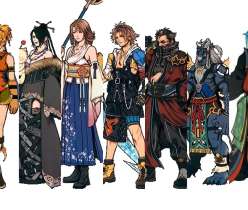Final Fantasy X is a game steeped in themes of fate, sacrifice, and the unseen forces that guide existence. Among its most profound explorations is the cycle of death and rebirth, woven through its depiction of Zanarkand, the Farplane, and the role of spirits in Spira. From Yuna’s summoning rituals to the lingering dead who refuse to move on, the game presents a thought-provoking commentary on life after death, reincarnation, and what it means to truly find peace.
The Farplane: A Spiritual Realm of Reflection
In Final Fantasy X, the Farplane serves as a visual and symbolic representation of the afterlife. When characters visit this ethereal space in Guadosalam, they can communicate with the spirits of the dead—so long as those souls have moved on peacefully. Unlike traditional representations of heaven or hell, the Farplane does not judge souls; rather, it serves as a resting place for those who have been “sent” by a summoner’s ritual.
But the Farplane is not all-encompassing. Some souls remain behind, clinging to the physical world due to unfinished business, grief, or sheer willpower. This concept aligns closely with spiritual beliefs in many cultures, where spirits linger as ghosts when they cannot accept their fate.
A Reflection of Buddhist and Shinto Ideals
The Farplane reflects ideas found in both Buddhism and Shintoism, two of Japan’s major spiritual traditions:
- Buddhism teaches that attachment binds spirits to suffering, mirroring the game’s unsent who cannot transition to the Farplane.
- Shinto beliefs center around spirits (kami) and ancestor veneration, much like how Spira’s people honor the dead in the Farplane.
This duality makes the Farplane both a place of peace and a mirror of human longing—some souls return in memory, while others refuse to let go, turning into fiends.
Zanarkand: A City Caught Between Life and Death
Zanarkand, the legendary lost city, is another profound symbol of the afterlife in FFX. Though it was destroyed a thousand years before the main story, it still “exists” in two forms:
- The Ruined Zanarkand – A husk of its former self, now a pilgrimage site.
- Dream Zanarkand – A mirage sustained by the Fayth’s dreams, where Tidus lived.
Zanarkand’s fate mirrors the concept of purgatory—a place neither fully alive nor dead. It exists as a memory of the past, projected into the present, much like a soul that refuses to transition to the afterlife.
Tidus himself is a manifestation of this cycle. He is not a living person, but a dream given form—a soul tethered between two realities. His journey from Zanarkand to Spira, and eventually his acceptance of his fate, represents the process of releasing attachments and embracing rebirth.
The Unsent: Souls in Limbo
One of Final Fantasy X’s most haunting themes is the existence of the unsent—beings who have died but refuse to pass on. These spirits, filled with regret or purpose, linger in the mortal realm. Some, like Seymour, use their unnatural existence for power, while others, like Auron, continue their mission out of duty.
- Auron remains because he promised to watch over Tidus. He does not succumb to corruption, but he is still bound to the past.
- Seymour, in contrast, clings to his pain, seeking to impose his twisted view of salvation onto Spira.
The fate of the unsent asks a key question: What happens when we refuse to let go? In FFX, spirits who reject the cycle either fade, transform into fiends, or corrupt the world around them.
Rebirth and Letting Go: Yuna’s Role as a Guide
At the heart of this journey is Yuna, a summoner who helps spirits move on. Her role is both literal and symbolic—she performs the Sending ritual, guiding souls to the Farplane, but she also serves as a guide for Tidus, Auron, and all of Spira.
By the end of the game, Yuna does something extraordinary: she breaks the cycle. Instead of perpetuating the doomed tradition of sacrificing summoners to defeat Sin, she chooses a new path, one that frees Spira from its cycle of suffering.
Tidus, too, embraces his own fate. He returns to the void from which he came, no longer clinging to his temporary existence. His goodbye to Yuna is one of acceptance—not of loss, but of transformation.
Final Thoughts: What Final Fantasy X Teaches About Death and Rebirth
Final Fantasy X doesn’t just tell a story about life and death—it asks us to reflect on our own attachments.
- Are we clinging to the past, like the unsent?
- Do we fear change, like the people of Spira?
- Or can we, like Yuna and Tidus, embrace the unknown and move forward?
The game suggests that death is not an end, but a transition, and that liberation comes not from resisting change, but from accepting it. Final Fantasy X reminds us that letting go is not the same as forgetting—it is the beginning of something new.
🌿 What do you think? How has Final Fantasy X changed your perspective on life, death, and rebirth? Drop your thoughts in the comments!


